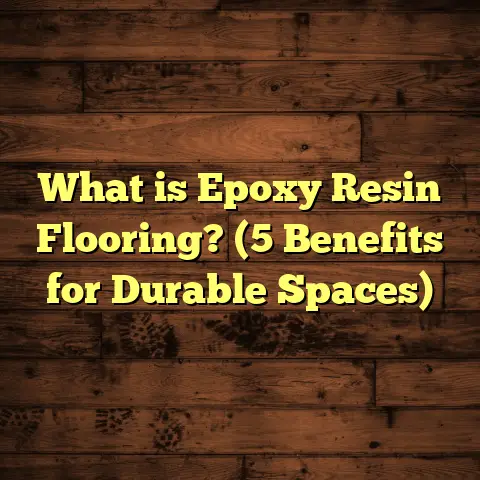What Is Average MM Thickness for WPC Floors? (5 Key Insights)
What Is Average MM Thickness for WPC Floors?
Have you noticed how WPC (Wood Plastic Composite) flooring has been gaining popularity everywhere? From modern urban apartments to bustling office spaces, WPC floors are becoming a favorite option for people who want durability combined with style. I’ve been working in flooring for years, and I’ve seen firsthand how the right thickness in WPC floors can make a huge difference in performance and comfort. But I often get asked, “What’s the average thickness for WPC flooring, and why should I care?”
Let me walk you through everything I’ve learned about this topic — from the basics to some insights I’ve picked up through personal projects and industry research.
Understanding WPC Flooring Thickness
Wood Plastic Composite flooring is a synthetic alternative to traditional hardwood or laminate floors. It mixes wood fibers with plastic polymers to create a product that looks like real wood but stands up better to water, scratches, and heavy use.
Thickness in WPC flooring refers to the total height of each plank, usually measured in millimeters (mm). This number isn’t just about how thick the floor looks — it impacts many aspects:
- Durability: Thicker floors resist dents and wear better.
- Comfort: Thicker planks often feel more solid and warmer underfoot.
- Sound insulation: More thickness can help reduce noise.
- Installation: Thickness can influence what subfloor types you can install over.
- Cost: Thicker boards generally cost more.
The thickness of WPC flooring usually ranges from 4 mm to 8 mm. But what thickness should you pick? And does thicker always mean better? I’ll answer those questions along with some important things most people don’t realize about WPC floor thickness.
1. The Typical Thickness Range: 6 to 8 mm
From my years of installing floors in different homes and commercial spaces, I can tell you that the most common thickness range for WPC floors is between 6 mm and 8 mm. This thickness range is popular because it balances strength and flexibility.
Why this range? When I worked on a project for a local daycare center, we went with 7 mm thick WPC planks. The floor needed to handle heavy foot traffic, occasional spills, and toys being dropped. The 7 mm thickness offered enough durability while still being easy to install.
On the other hand, I helped a friend install WPC flooring in his vacation cabin and went with 6 mm thick planks. Since this space isn’t used daily, 6 mm was perfect — sturdy enough but more budget-friendly.
Data Point: According to a flooring industry survey from 2023, about 65% of residential WPC floor installations fall within this 6-8 mm thickness range.
Why Not Go Thinner or Thicker?
I once tried installing a thinner WPC floor (around 4 mm) in a small office space to save costs. It felt flimsy underfoot and produced an annoying hollow sound when walked on. The client ended up replacing it within two years due to wear and damage.
Conversely, thicker floors (above 8 mm) are sometimes marketed as “premium,” but they can be overkill for residential use and add extra cost. Plus, thicker floors might require cutting door frames or adjusting thresholds during installation.
2. Wear Layer Thickness Is Even More Important
One thing that surprises many people is that the overall plank thickness isn’t the only factor determining a WPC floor’s durability — the wear layer thickness plays an even bigger role.
The wear layer is the transparent top coating on each plank that protects against scratches, stains, and fading. It’s usually made from materials like aluminum oxide or ceramic particles.
Typical wear layer thicknesses range from 0.3 mm to 0.7 mm or more:
- 0.3-0.4 mm: Suitable for light residential use.
- 0.5 mm: Standard for most residential applications.
- 0.6-0.7 mm: Recommended for commercial or high-traffic areas.
From personal experience, I always recommend clients choose at least a 0.5 mm wear layer for normal household use. For example, when installing in a busy restaurant’s dining area, we selected planks with a 0.7 mm wear layer—those floors have held up very well after two years despite heavy foot traffic.
Why Does the Wear Layer Matter So Much?
I remember working on an office renovation where the WPC flooring had an excellent overall thickness of 7 mm but only a 0.3 mm wear layer. After just one year, there were visible scratches and scuffs all over. The client regretted not opting for a thicker wear layer initially.
The wear layer acts as your floor’s first line of defense against everyday damage — think of it as the armor plate protecting your investment.
3. Thicker Boards Provide Stability and Comfort
Have you ever walked across a floor that felt like it might crack or flex beneath your feet? That’s usually because the boards are too thin or have a weak core.
WPC flooring is designed with a composite core that combines wood fibers and plastic polymers for strength and resilience. But plank thickness affects how stable and comfortable the floor feels.
In one of my projects involving a yoga studio, we chose 8 mm thick WPC boards because clients often sit and stretch on the floor. They needed something that felt firm but cushioned enough not to hurt joints.
Thicker planks also improve sound insulation by reducing footfall noise — something people living in apartments really appreciate.
The Science Behind Comfort
The thicker the plank, the more material there is to absorb shock and reduce noise transmission. For instance:
- A thinner plank (4-5 mm) may transmit more noise to rooms below.
- A thicker plank (7-8 mm) provides better sound dampening, leading to quieter spaces.
Many manufacturers will also add an underlayment layer beneath WPC floors to boost comfort and noise reduction, but having a solid base plank helps tremendously.
4. Installation Factors Influence Thickness Choice
WPC floors are typically designed for floating installation — meaning they click together without glue or nails and rest over an existing subfloor.
The condition of your subfloor affects which thickness works best:
- Uneven Subfloors: Thicker planks (7-8 mm) help hide minor imperfections better.
- Smooth Surfaces: Thinner planks (5-6 mm) can work fine if your surface is level.
- Glue-down Installation: If you plan to glue down your floors (more common in commercial settings), thickness matters less since adhesive stabilizes the boards.
I once installed thinner (5 mm) WPC flooring on top of a concrete slab in a condo renovation. Because the slab was perfectly level, the floor felt solid and stable.
Also consider practical concerns like door clearance: thicker floors might require trimming doors or adjusting thresholds during installation.
Real-Life Example: Client Advice
A client called me frustrated because their chosen WPC planks were too thick to fit under their existing doors without trimming them extensively. The solution? Switching to slightly thinner planks solved the problem without compromising durability too much.
Always measure door heights before ordering flooring!
5. Regional Climate & Market Trends Affect Thickness Preferences
Where you live can influence what thickness of WPC flooring makes sense.
In colder or humid climates, people tend to prefer thicker floors (7-8 mm) because they offer better moisture resistance and insulation against cold subfloors.
For example, in northern states like Minnesota or Canada, thicker WPC floors are popular precisely because they provide warmth and better protection from moisture infiltration through concrete slabs.
In warmer regions like southern California or Florida, thinner planks (5-6 mm) are more common since moisture isn’t as big an issue and people prioritize easier installation and lower cost.
Industry Data: Market Breakdown by Region
According to recent sales data from major flooring suppliers:
- North America: ~60% of WPC floors sold are between 6-7 mm thick.
- Europe: Wider range between 5 mm and 8 mm depending on country and usage.
- Asia: Diverse preferences; urban areas favor thinner planks for cost reasons, rural areas lean towards thicker products for durability.
My Own Flooring Project: Kitchen Renovation Story
Last year, I decided to redo my kitchen floor using WPC because I wanted something waterproof yet natural-looking. After researching options, I chose:
- Thickness: 7 mm
- Wear Layer: 0.6 mm
Why? The kitchen gets heavy use — spills, dropped pans, pets running around — so I needed strong protection without going overboard on cost or installation difficulty.
Installation went smoothly over my existing tile subfloor using floating method. Since then, I’ve noticed how solid the floor feels when standing for long periods cooking or cleaning. Plus, cleanup is easier than with hardwood because water doesn’t seep in.
Thickness Alone Doesn’t Tell the Whole Story
Thickness is just one piece of the puzzle when choosing WPC flooring:
- Core Density: A denser core means better resistance to dents and moisture.
- Material Quality: High-quality polymers resist UV fading and scratches better.
- Manufacturer Standards: Some brands test to specific wear and impact ratings.
- Installation Method: Floating vs glue down changes how the floor behaves.
- Underlayment: Adds cushioning and soundproofing independent of board thickness.
I remember encountering an 8 mm thick WPC floor from a low-cost brand that dented easily because its core was soft and poorly manufactured.
So never pick based solely on thickness — check specs carefully!
How To Choose The Right Thickness For Your Project
Here’s how I guide clients through this decision:
- Identify Usage: Is it residential or commercial? High traffic?
- Check Subfloor Type: Concrete slab? Wood? Level?
- Consider Climate: Cold/humid or warm/dry?
- Look at Wear Layer: Minimum 0.5 mm for homes; thicker for commercial.
- Budget Constraints: Thicker = higher price but longer lifespan.
- Ask About Core Density & Warranty: Better quality often lasts longer.
- Think About Installation Details: Door clearance, floating vs glue-down.
- Get Samples: Walk on them before deciding!
Common Questions About WPC Thickness
Can I install thinner WPC flooring in low-use rooms?
Yes! In bedrooms or guest rooms with light foot traffic, thinner boards around 4-5 mm with at least a 0.3 mm wear layer may be fine — but be prepared for shorter lifespan compared to thicker options.
Does thicker mean harder to clean?
Not really. Cleaning depends more on surface finish than thickness. Both thin and thick WPC floors clean easily with regular sweeping and damp mopping.
Will thicker boards raise my floor height too much?
They will add some height — usually between about 1/4 inch (6 mm) and 5/16 inch (8 mm). Consider transitions between rooms carefully if using thicker planks.
How does thickness affect warranty length?
Manufacturers often offer longer warranties on products with thicker wear layers and higher quality cores, but total plank thickness alone doesn’t guarantee warranty length.
Summary Table: Average Thickness & Wear Layer Recommendations
| Use Case | Total Thickness (mm) | Wear Layer Thickness (mm) | Notes |
|---|---|---|---|
| Light residential | 4 – 6 | 0.3 – 0.4 | Bedrooms, guest rooms |
| Standard residential | 6 – 7 | ~0.5 | Living rooms, kitchens |
| High traffic residential/commercial | 7 – 8 | 0.6 – 0.7 | Offices, restaurants |
| Specialty spaces (gyms/yoga studios) | ~8 | ≥0.6 | Extra comfort & durability |
Final Thoughts From My Flooring Experience
I hope this detailed look at WPC flooring thickness helps you understand why those millimeters matter so much! Over the years, I’ve learned that selecting the right thickness isn’t just about numbers — it’s about matching your floor to how you live or work.
If you want durability with comfort underfoot, aim for around 6-7 mm total thickness with at least a 0.5 mm wear layer in residential settings.
For heavy-use areas or commercial projects, don’t hesitate to go up to 7-8 mm with thicker wear layers for peace of mind.
And remember: Always consider core quality, installation needs, climate factors, and budget alongside thickness before making your final choice.
Got questions about your own project? Feel free to ask anytime! Flooring decisions can feel overwhelming at first but getting these details right sets you up for years of satisfaction beneath your feet.





